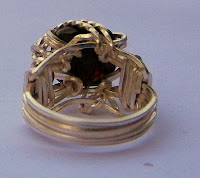I have been longing to learn to sculpt flowers in Premo. It occurred to me about a month ago that the cutters and shapers that cake decorators employ would probably translate very well to polymer clay. That turned out to be true! I bought one of the Wilton's sets of cutters and molds and went to work.
The first flower I tried was the rose. I have an antique rose bush in my yard with lovely variegated purple petals. It is a cabbage rose and I didn't quite succeed in approximating the number of petals on one of those, but I did manage to variegate the petals by making a Skinner blend from white to dark purple and then cuttin the petals out of that blend and staggering the light and dark tones to make it look as natural as possible. For the calyxes, I took a piece of scrap gray-green clay and mixed with Sea Green to get a more lifelike color. The earrings also have green aventurine similar to a flower stem. I was pretty pleased with the way this ensemble turned out. It was an education in how easy it is to lose your texture and petal separation and really calls for a steady hand.
The next flower to try was the Dogwood. I have been dying to try to sculpt these, because it is the state flower of North Carolina and I believe if I can master making these, there is bound to be a market somewhere. I couldn't really see a way to do a Skinner blend for the indentions of the petals, so I used liquid polymer and Lumiere acrylics and alcohol inks to approximate the shading on the petals. The next time I make these dogwoods, the petals will probably be thicker. These are incredibly thin, but it does add to their flexibility. Once the dogwoods were made I cast around for the perfect beads to complement them. I was at a total loss until my eye glanced at the red and black ladybug beads that I have had for probably eleven years, trying to discern their purpose. They look great with the dogwoods!
On to the African violets! A walk through the neighborhood filled my eyes with visions of the beautiful colors, shapes and textures. The woodland violets and the pansies especially appealed to me with their hues of purple, red, yellow, and blue against the lovely green of the leaves. I started making a cane with an orange center, then violet, then white and then purple. These flowers were cut out with a two piece molding gun and then feathered a little around the edges for a more natural petal look. The leaves were individually molded and then assembled and connected so that they would provide a sturdy bas3 for the flowers. The pendant hangs from a sterling silver chain and the earrings hang from sterling hand made french wires. When I walked through the grocery store this afternoon and saw some African violets for sale, I knew I had succeeded.
This is my beginning excursion into creating flower jewelry, so the sky appears to be the limit on creativity. Come and join me and remember that the journey is far more important than the goal.
Merry Christmas from my House to Yours!
-
Things are quite different for me without my mom this year at Christmas. I
was enjoying putting out some of my favorite Christmas decor items but I
was ...
1 week ago



































































































